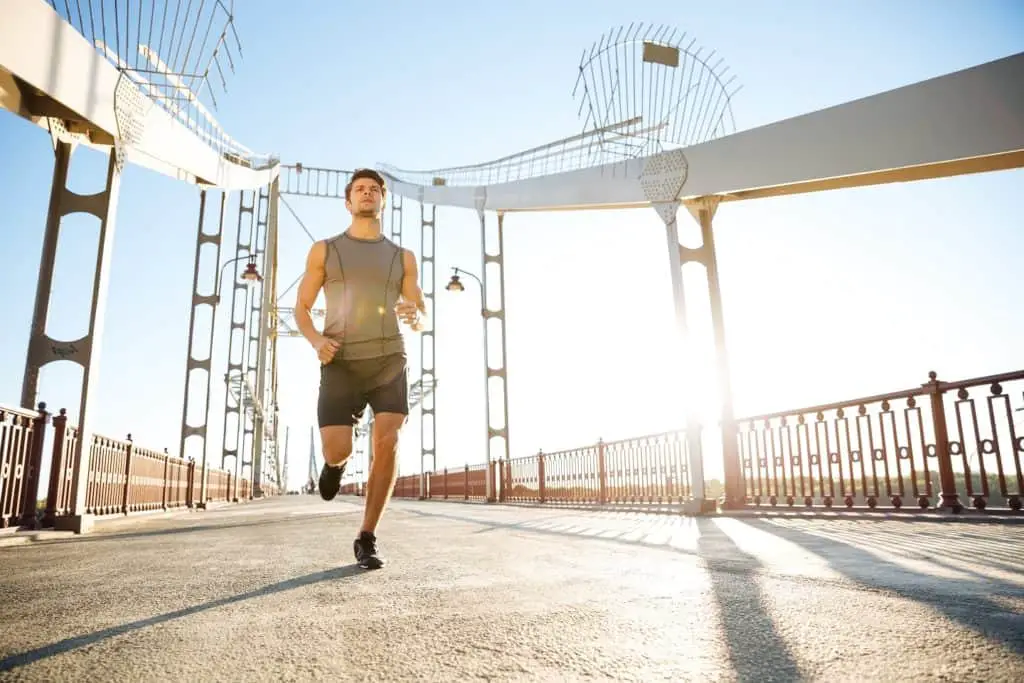Short Version: Running shoes with good cushioning and the right support for you.
Running on concrete isn’t a problem when you have the right shoes. Most of us inevitably find ourselves running in urban areas with hard surfaces.
Concrete is a harder surface to run on than grass but that shouldn’t put you off. Millions of runners are pounding the concrete every day all around the world.
This guide will help you find the best shoes for running on concrete for you.
Table of Contents
Buyers Guide
We runners love to run. Anything that can help our legs recover faster ready for our next run is big bonus. Running shoes that have good quality cushioning to protect our legs from pounding concrete will just that. Here are some other points to consider.
Rocker Action
We all like to imagine ourselves running, no, flying down the road with our feet barely touching the surface. The bad news is this isn’t the case for most of us all the time. Any help we can get with that especially on concrete is a good thing.
Brands such as Hoka build a rocker into their shoes that encourage a rolling, moving forward motion. The aim is to avoid the heavy plodding gait we are all familiar with at the end of a long run when we are tired.
Correct Support
If you’ve tried to increase your milage slightly too quickly you’ll be very familiar with that plodding gait mentioned. When you reach that point you need to consider the risks vs the reward. The injury risk increases as the running benefits are reducing.
A shoe with the correct support will help reduce that risk, especially if you are running on concrete. If you can feel your feet moving around in your running shoes or they feel unstable, its time to replace them (the shoes that is).
Cushioning
Cushioning that doesn’t deform will help prevent injury when running on the hard stuff. The good news is that all premium running shoes with good cushioning will help here. The differences start after a few hundred miles of use, some will retain their cushioned bounce better than others.
If the midsole in your running shoes looks deformed, compressed or damaged. Its time to invest in a new pair.
Durability
Buy a pair with a good amount of rubber on the sole. The perfect running shoe will have a sole and midsole sole that will expire at roughly the same time.
You don’t want to see exposed midsole peeking through a worn out sole when the midsole still looks pristine.
Other Considerations
A couple of other related tips for when you run on hard concrete.
Unnaturally Regular
Under normal circumstances concrete and other man made surfaces are very flat. Running on a surface that is consistent in the extreme makes a runner prone to an over use injury.
The consistency of the surface is mirrored in your gait. Large and small muscles fatigue while others are left relatively idle. This can lead to those fatigued muscles becoming injured. And can expose the runner as being slightly one dimensional when faced with different terrain.
If these a grass verge along the road you run on, hop onto that for a while. Try changing where you run. Find some hills or a trail.
Mix it up
You may be reading this after getting hit with an injury from running on concrete. As mentioned it probably wasn’t the hardness of the concrete that caused your injury but its extreme flatness.
After you’ve evaluated your running shoes and maybe invested in some new ones. Think about where you been running and how you can mix that up bit. Get off road and find some trails.
This academic study found that grass is a preferable surface to run on for most runners. It’s a fascinating read and found that grass is a more compliant surface to run on than concrete or asphalt. But it isn’t always possible. I don’t have a 10k route anywhere near me that would be exclusively done on grass.
Shoe Rotation
The repetitive nature of running is emphasised when running exclusively on the same concrete week in week out. Having two or even three pairs of shoes in your rotation will help avoid those injuries caused by repetitive running.
Specifically the heel to tow drop. Most Hokas have a drop of 5mm while the Nike Pegasus 37’s have a 10mm drop. Swapping between the two for runs during the week will change how the muscles in your legs are used while you are running.
Add in some zero drop shoes and you’ll change things even more. However, please do be careful about adding in zero drop shoes. They do have their own considerations.
Recovery Game
Improve your recovery game if you find your legs are still sore after a couple of days of rest. If you find yourself reading this because you want to run more but it takes days for you to recover. Take a look at your recovery process. Do you have a foam roller, a massage gun, are you taking a post run recovery drink?
Conclusion: Best Shoes For Running On Concrete
Buy shoes premium shoes with good cushioning and the right amount of stability for you.
Buy two different pairs with different heel to toe drop height.
If your legs still feel sore try improving your recovery game.

Frequently Asked Questions
How hard is concrete compared to asphalt?
Concrete is about 10 times harder than asphalt when measured in a hydraulic press. However, theres very little difference between running on concrete and asphalt. Asphalt doesn’t deform when the average car runs across it so it wont when you run on it.
Are there benefits to running on grass rather than concrete?
Yes. Running on grass puts less pressure on your muscular skeletal system than running on concrete or asphalt. Take a look at this academic study.

